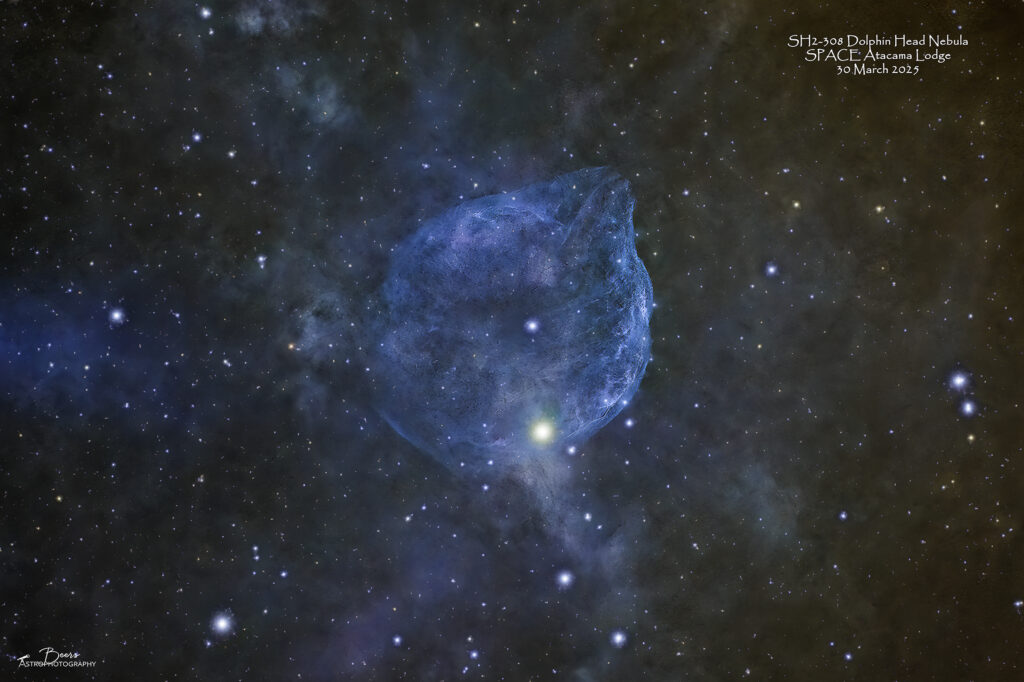
Fun facts
Sh 2-308, also designated as Sharpless 308, RCW 11, or LBN 1052, and commonly known as the Dolphin Head Nebula, is an HII region located near the center of the constellation Canis Major, composed of ionized hydrogen. It is about 8 degrees south of Sirius, the brightest star in the night sky. The nebula is bubble-like and surrounds a Wolf–Rayet star named EZ Canis Majoris. This star is in the brief, pre-supernova phase of its stellar evolution. The nebula is about 4,530 light-years (1,389 parsecs) away from Earth, but some sources indicate that both the star and the nebula are up to 5,870 ly (1,800 pc) away. Yet others indicate the nebula is as close as 1,875 ly (575 pc) from Earth.
Sh 2-308 surrounds the central star Wolf–Rayet star EZ Canis Majoris, also designated EZ CMa or WR 6. Its apparent magnitude varies from 6.71 to 6.95. Its spectral type indicates that the star is very hot and luminous. The spectrum shows that it is devoid of hydrogen at the surface. EZ Canis Majoris is expected eventually to explode in a supernova, therefore subsuming the nebula.
The nebula was formed about 70,000 years ago by the star EZ Canis Majoris throwing off its outer hydrogen layers, revealing inner layers of heavier elements. Fast stellar winds, blowing at 1,700 km/s (3.8 million mph) from this star, create the bubble-shaped nebula as they sweep up slower moving material from an earlier phase of the star’s evolution. The hydrogen composing the nebula is ionized by intense ultraviolet radiation. The nebula is approximately 60 light-years across at its widest point.
The most favorable period for observing the nebula in the night sky is between the months of December and April. Its southern declination makes it easier to observe from the Southern Hemisphere, though it is visible from most of the Northern Hemisphere as well. It appears as a faint cloud in photographs taken with high-power amateur instruments, with the help of special filters.
Location: RA: 06h 54m 13s / DEC: -23° 55’ 42”
Distance: 4530 light years
Radius: 30 light year
Apparent Dimensions: 35’ x 35’
Apparent Magnitude: 7.0
Constellation: Canis Major
Designations: Sh-308, RCW 11, LBN 1052
{ From: https://en.wikipedia.org/wiki/Sh_2-308 }
Capture & Processing Notes
You may remember (if it you don’t, that is very OK!) the bad and the ugly SH2-308 Dolphin Head Nebula I captured from the front patio in late November 2024, posted with a comment saying “this is a complete placeholder, with hopefully the good to come from imaging sessions in the Southern Hemisphere where it won’t be so close to the horizon (and I’ll be in dark skies)”. So, here is the good to complement the former bad and ugly (which has since been removed from the gallery) Southern Hemisphere image. The target’s declination (DEC: -23° 55’ 42”) placed it essentially overhead at the Atacama Lodge!
Atacama Lodge 2025 trip Capture Notes: The Dolphin Head is an object I’ve been intrigued with since I saw it as a potential target – to capture for Paul (as a tribute to his Navy submarine time and the dolphins he wore to signify that service). I’ve made a mess trying to capture it from home. Looking at the RA/Dec after my last attempt, I moved it to my Southern Hemisphere target list. When the telescope slewed to the target, it was directly overhead, as opposed to the low inclination angle looking through atmosphere and light pollution from home.
The capture went exceedingly well. I could hear Danita’s voice from last year saying “practice makes perfect” at about this point in the trip! That is indeed the case!! The polar alignment was accomplished in less than 2 minutes!! Quite the improvement from the first night’s 2 hours, the second night’s 6 hours, and the previous night’s 30 minutes! I was even able to accomplish the polar alignment before complete dark at 20:19-20:21CDT. The rest of the SGP sequence start-up also went flawlessly. I started the process (having to disconnect and stow the Polemaster camera and cord, connect the cabling, remove lens caps, and power on the mount) at 20:26CDT, the first subframe was captured at 20:38CDT!
The target was past its meridian flip before I started the sequence, so I imaged it from that point (~45 minutes past the meridian) until it set at 01:05CDT.
Sequence Plan (30Mar2025): Gain 158, Offset 30, Temp 0°C; 49x5min. Captured 30Mar2025, 20:37CDT – 31Mar2025, 01:04CDT. Total exposure time: 4:05hrs.
Processing summary: Captured in SGP, stacked in APP (Adaptive Airy Disc), star removal with Starnet++, processing with LR/PS
Equipment
Equipment: All equipment controlled by HP Probook running Sequence Generator Pro v4.4.1.1441.
- Imaging (ASI2400-SC): ZWO ASI2400MC imaging camera; (Southern Cross) Askar FRA600 108mm f/5.6 Quintuplet Petzval Flat-Field Astrograph
- Autofocuser: ZWO EAF Electronic Automatic Focuser – Standard (EAF-5V-STD)
- Mount: Rainbow Astro RST-135E (controlled by iHubo ASCOM driver)
- Polar alignment: QHYCCD camera (controlled by Polemaster for polar alignment)
- Autoguiding: Orion 60mm Multi-Use Guide Scope with Orion StarShoot AutoGuider Pro Mono Astrophotography Camera (controlled by PHD2)
Summary
Captured: Captured 30Mar2025, 20:37CDT – 31Mar2025, 01:04CDT. Total exposure time: 4:05hrs.
Shooting location: San Pedro de Atacama Celestial Explorations (SPACE) Atacama Lodge, Chile
Equipment: Southern Cross on Rainbow Astro RST-135E
Processing summary: Captured in SGP, stacked in APP, star removal with Starnet++ v2, processing with LR/PS
